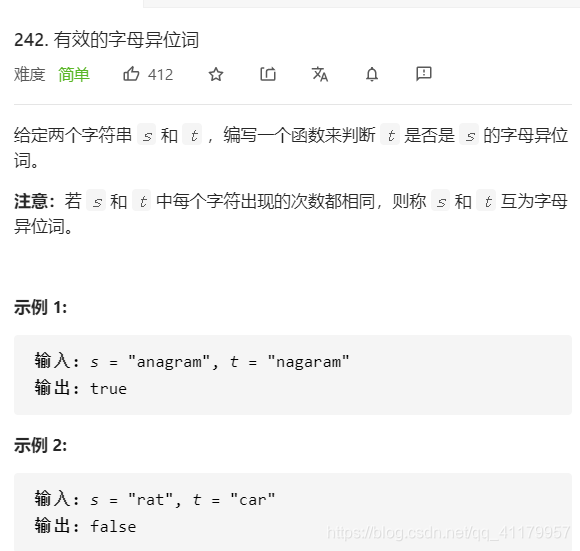?解题思路:
1.hashmap:? ? ?hashmap = defaultdict(int)
2.循环字符串:把前后字符串拼在一起
3.反转字符串? a = b [::-1]

class Solution:
def isAnagram(self, s: str, t: str) -> bool:
dict1 = defaultdict(int)
dict2 = defaultdict(int)
for s1 in s:
dict1[s1] += 1
for s2 in t:
dict2[s2] += 1
return dict1 ==dict2
暴力破解法:时间复杂度N^2,超时了
class Solution:
def countSubstrings(self, s: str) -> int:
l = len(s)
print(l)
ans = 0
for i in range(l):
for j in range(i+1,l+1):
string = s[i:j]
print(string)
if self.Isomorphic(string):
ans += 1
return ans
def Isomorphic(self,s):
return s == s[::-1]方法2:回文中心法:
class Solution:
def countSubstrings(self, s: str) -> int:
n = len(s)
ans = 0
for i in range(2*n-1):
left = i // 2
right = left + i % 2
while left >= 0 and right < n and s[left] == s[right]:
left -= 1
right += 1
ans += 1
return ans
class Solution:
def isPalindrome(self, x: int) -> bool:
if x == 0:
return True
if x < 0 or x % 10 == 0:
return False
right = 0
while(x > right):
right = right * 10 + x % 10
x = x // 10
return x == right or right // 10 == x

思路:
定中心位置后向两边延申:
python 异或符号 ^?
class Solution:
def countBinarySubstrings(self, s: str) -> int:
n = len(s)
cnt = 0
for i in range(n-1):
left = i
right = i+1
while left >= 0 and right <n:
string = s[left:right+1]
zero = string.count('0')
one = string.count('1')
if zero == one:
print(left,right, string)
cnt += 1
left -= 1
right += 1
if left < 0 or right >= n or s[left] != s[left+1] or s[right] != s[right -1]:
break
return cntclass Solution:
def countBinarySubstrings(self, s: str) -> int:
n = len(s)
cnt = 0
for i in range(n-1):
left = i
right = i+1
if int(s[left]) ^ int(s[right]) == 1:
while left>=0 and right < n:
if s[left] == s[i] and s[right] == s[i+1]:
cnt += 1
left -= 1
right += 1
else:
break
return cnt?